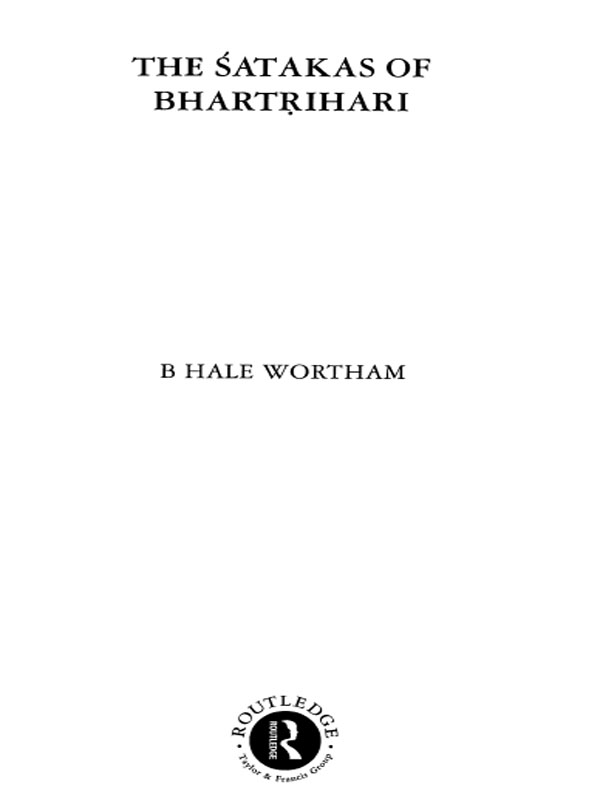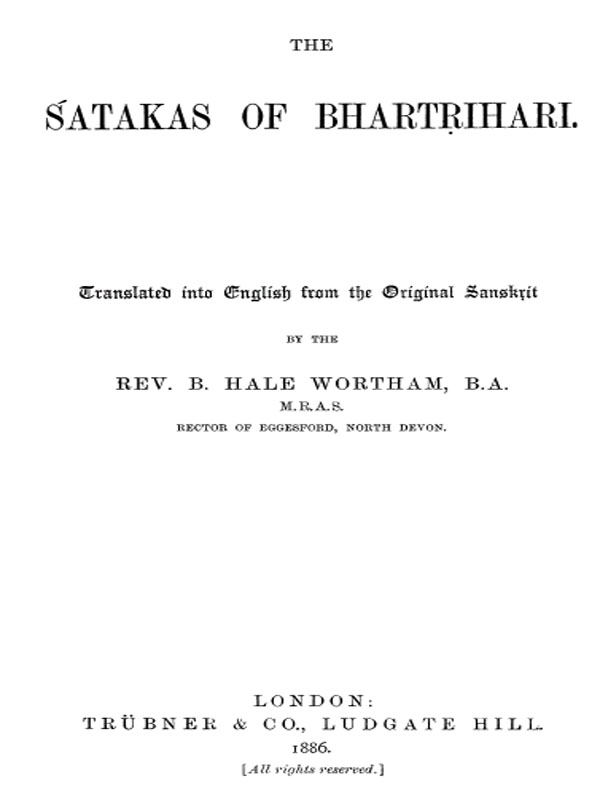
Trbners Oriental Series
INDIA: LANGUAGE AND LITERATURE
In 14 Volumes
I | Indian Poetry
Edwin Arnold |
II | A Sketch of the Modern Languages of the East Indies
Robert N Cust |
III | Lays of Ancient India
Romesh Chunder Dutt |
IV | The Birth of the War-God
Ralph T H Griffith |
V | The Bengali Drama
P Guha-Thakurta |
VI | Miscellaneous Essays Relating to Indian Subjects Vol I
Brian Houghton Hodgson |
VII | Miscellaneous Essays Relating to Indian Subjects Vol II
Brian Houghton Hodgson |
VIII | Metrical Translations from Sanskrit Writers
J Muir |
IX | The Spirit of Oriental Poetry
Puran Singh |
X | The History of Indian Literature Albrecht Weber |
XI | The atakas of Bhartihari
B Hale Wortham |
XII | Behar Proverbs
John Christian |
XIII | A Classified Collection of Tamil Proverbs
Herman Jensen |
XIV | Folk-Tales of Kashmir
J Hinton Knowles |

First published in 1886 by
Trbner & Co Ltd
Reprinted in 2000, 2002 by
Routledge
2 Park Square, Milton Park, Abingdon, Oxon, 0X14 4RN
Transferred to Digital Printing 2007
Routledge is an imprint of the Taylor & Francis Group
1886 B Hale Wortham
All rights reserved. No part of this book may be reprinted or reproduced
or utilized in any form or by any electronic, mechanical, or other means,
now known or hereafter invented, including photocopying
and recording, or in any information storage or retrieval system, without
permission in writing from the publishers.
The publishers have made every effort to contact authors/copyright holders
of the works reprinted in Trbners Oriental Series.
This has not been possible in every case, however, and we would
welcome correspondence from those individuals/companies
we have been unable to trace.
These reprints are taken from original copies of each book. In many cases
the condition of these originals is not perfect. The publisher has gone to
great lengths to ensure the quality of these reprints, but wishes to point
out that certain characteristics of the original copies will, of necessity, be
apparent in reprints thereof.
British Library Cataloguing in Publication Data
A CIP catalogue record for this book
is available from the British Library
The Satakas of Bhartihari
ISBN 0-415-24510-9
India: Language and Literature: 14 Volumes
ISBN 0-415-24289-4
Trbner s Oriental Series
ISBN 0-415-23188-4
ISBN 9781136387289 (ebk)

TO
EDWARD BYLES COWELL, ESQ., M. A., LL.D.,
PROFESSOR OF SANSKRIT IN THE UNIVERSITY OF CAMBRIDGE.
PREFACE.

O F the three atakas or centuries of couplets ascribed to Bhartihari, the Nti and Vairgya atakas alone are included in the following pages. The rigra ataka contains so many stanzas requiring modification, so many more wholly untranslatable into English, that on due consideration I have decided to omit this collection of stanzas from the volume now published. It only remains for me to convey my thanks to the friends who, in various ways, have so kindly and willingly contributed their aid in helping me to carry out this work.
B. H. W.
INTRODUCTION
TO
THE ATAKAS OF BHARTIHARI.

W HO was Bhartihari? what was his date? where did he live? did he, in fact, ever really exist at all? These are questions to which no satisfactory answer has as yet been given. It has been alleged that he was of regal descent, and the brother of Vikramditya; that not only did he belong to a reigning family, but that he was next in succession to the crown, and that, disgusted with the world, he resigned in favour of his brother Vikrama.
He is the reputed author of three atakas or centuries of couplets:
1. rigra ataka, a purely amatory poem;
2. Nti ataka, on polity and ethics;
3. Vairgya ataka, on religious austerity.
Besides these, tradition assigns to him a grammar called Vkyapadya, and a poem called Bhaikavya.
But beyond tradition there is no evidence whatever as to the authorship of these atakas. The theory already referred to, that Bhartihari was a prince who quitted the world in disgust, is founded upon the somewhat vague allusions in the second loka of the Nti ataka. This has been supposed to refer to the discovery of a domestic intrigue in his own household, which so shook Bhartiharis faith in worldly matters, that he decided to abdicate his royal position, and to retire into the forest as an ascetic.
These conclusions seem, however, too much to deduce from a remark in itself somewhat obscure. But whoever the author may have been, there seems a continuity and a uniformity in each of these separate atakas, as well as a similarity in character between them, which forbid us to accept the theory that they are merely a compilation of well-known sayings. The unbroken tradition, moreover, that they are the authorship of one man (whatever his name may be) should not go for nothing.
The question of date is almost as difficult to decide as that of authorship, and this can only be arrived at approximately on internal evidence. The doctrines enunciated in the Vairgya ataka are relied on as supplying us with some of the proofs that are required. Many of the lokas in this ataka speak in the language of the Vedantic philosophy. The rooting out of Karma or action, absorption into the Supreme Spirit, the driving out of Moha or illusion by Jnna, or the true knowledgethese ideas occurring very frequently in the Vairgya ataka, all point to Vedantic influence. The eighth or ninth century A.D. has, on these grounds, been assigned as the date of these atakas. Not that this date can be held as conclusive; for though Sankarcharya, the great exponent and formulator of the Vedantic philosophy flourished and taught at that date, it is not, therefore, proved that the Vedantic doctrines did not exist before his time; and it necessarily follows, therefore, that neither similarity of idea nor of phraseology can warrant us in making Bhartiharis atakas cotemporary with Sankarcharya.
The argument as to their date from the mention of the Purnas in the Vairgya ataka seems to be equally unconvincing. Some of the Purnas may be even comparatively modern productions, as late as the fourteenth or fifteenth century; but some are much earlier, dating back to the fifth or sixth century A.D. Further, the contents of these Purnas may be carried back to an even
Telang, in the preface to his editions of the Nti and Vairgya atakas, is in favour of assigning the close of the first or beginning of the second century to the author of these philosophical poems, in opposition to some authorities, who would place his date at 56 A.D. He grounds his view on the following considerations. Tradition informs us that the author of the atakas was Bhartihari, the brother of King Vikrama, and that he also composed a grammatical work called the Vkyapadya. This work shows us that its author lived at least one generation after Patanjalis commentary on Paninis Grammar, called Mahbhshya, had come into general use. The date of Patanjali varies according to different authorities from 200 B.C. to 25 A.D. Bhartihari, in the Vkyapadya, notices the fact that the Mahbhshya had gone through changes and rearrangements of text; possibly interpolations and additions. The period between 144 B.C. (which Telang considers the probable date of Patanjali) and 56 B.C. would have been hardly long enough to account for alterations and interpolations in the text of the Mahbhshya, and therefore 56 B.C., as the date of Bhartihari, must be abandoned. We have, however, seen that Vikramditya was said to be the brother of Bhartihari. Now there appears to be a general consensus of opinion that this Vikramditya was the founder of the aka era, and that he lived about 78 A.D.
Next page






